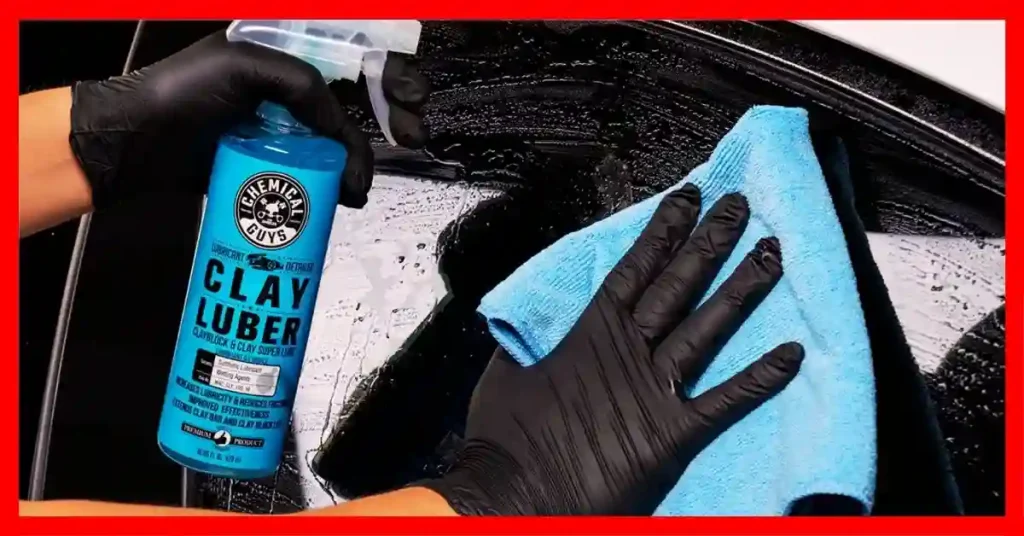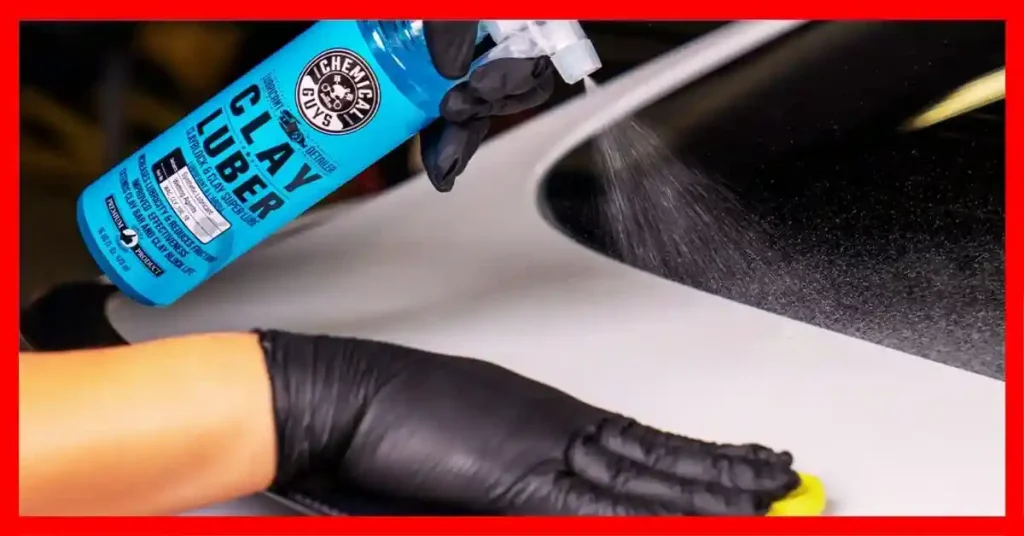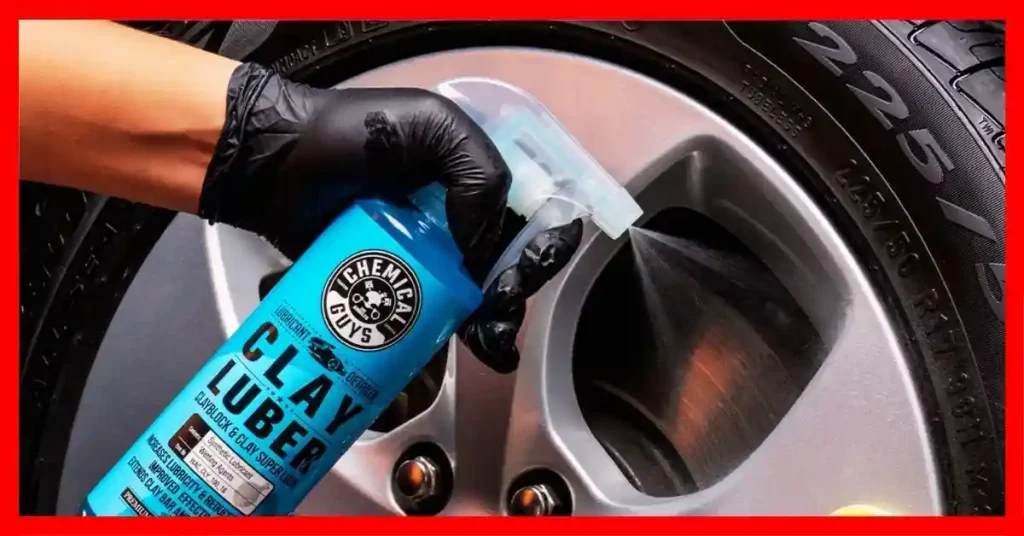Ever drag a clay bar across your car and feel it stick or stutter? I’ve been there. The first time I skipped the right lube, I ended up with tiny scratches and a lot of regret. That’s when I started hunting for the best clay bar lubricant—something smooth, safe, and easy to use. After trying a few options, Chemical Guys Clay Luber became my go-to. In this guide, I’ll walk you through what I’ve learned, what to avoid, and how to make claying your car feel like butter on glass. Let’s get into it.

Why You Need a Clay Bar Lubricant in the First Place
If you use a clay bar, you need a clay bar lube. It keeps the clay smooth on your car. Without it, the clay can stick. That can leave marks or scratch your paint.
What do you spray with a clay bar? You spray clay bar lube. It helps the clay glide. It also lifts dirt off the paint. This keeps the clay from dragging.
What liquid can you use with a clay bar? You should use a clay bar lube. Water is not slick enough. Quick detailers can work, but not all of them. Real clay lube is safer.
If you clay without lube, bad things can happen. The clay may grab the paint. That can leave lines or swirls. You’ll then need to polish it out.
I tried using soapy water once. It made the clay stick and tear. The job took longer, and I had to fix the damage. Since then, I stick with real lube.
My Top Pick: Chemical Guys WAC_CLY_100_16 Clay Luber
After years of testing different clay lubes, Chemical Guys Clay Luber is the one I keep coming back to. It’s slick, safe, and works like a charm every time. If you’re asking, “What’s the best clay bar lubricant?” — this is the one I use and trust.
I first tried it on my daily driver after a long road trip. Bugs, tar, and grit were stuck to the paint. I used the Clay Luber with a medium clay bar, and it felt like the bar was floating across the surface. No grabbing. No marring. Just smooth strokes and clean results.
What I love most is how it feels when you use it. The spray comes out even and coats well. It smells clean, not like harsh chemicals. And unlike plain water or DIY mixes, it doesn’t dry out fast. That alone saves time and prevents damage. This clay lube helps your clay bar glide with zero drag, making it safer for your paint, glass, or even vinyl wrap.
The formula has what they call “synthetic wetting agents” — sounds fancy, but it just means it stays slippery. I’ve used it on paint, headlights, chrome trim, vinyl decals, even rubber window seals. Never had streaks, haze, or dull spots after.
I remember one weekend I detailed a friend’s old Civic. The hood had that rough sandpaper feel. After a wash and some Clay Luber, it went from gritty to glassy. We were both shocked. That before-and-after sold me for good.
If you’re claying your car and want to play it safe, this is the clay bar lubricant that works — every single time. It’s easy to use, and it’s built for beginners and pros alike.
Pros and Cons of Chemical Guys Clay Luber
Let’s talk about what this clay lube gets right—and where it could use a little help.
✅ Incredibly slick and safe for multiple surfaces
This stuff is slick. Like, ice-on-glass slick. That means your clay bar glides across the paint without sticking. I’ve used it on clear coat, glass, headlights, even soft plastic trims—and never once saw a scratch. If you’re wondering “What clay lube is safe for all parts of my car?” — this is it.
✅ Works with any clay bar or synthetic mitt
No matter what clay tool you’ve got—traditional bar, mitt, or towel—this lube plays nice. I’ve even mixed brands (Adams clay mitt + this lube) and it still worked like a charm. It’s a great all-around clay bar lubricant for beginners and pros alike.
✅ Available online and in local stores
You can grab it on Amazon, or find it at local auto parts shops. That’s a big win when you’re short on time and just want to get the job done.
❌ Bottle may crack if dropped
One heads-up: the plastic bottle isn’t the toughest. I dropped it on my garage floor once and got a small crack. Now I transfer it to a tougher spray bottle before claying. So if you’re clumsy like me, handle with care.
❌ Blue dye can stain hands – wear gloves
It’s bright blue, and yes—it can stain your fingers a bit. It washes off, but still, I now wear nitrile gloves just to keep things clean. If you’re doing a full detail, you’re better off gloved anyway.
Bottom line: Chemical Guys Clay Luber has way more pros than cons, and the few downsides are easy to work around. If you’re looking for a lube that works fast, protects your paint, and is easy to find, this is it.

👉🏿👉🏻 Check Latest Price and Offer at Amazon 👈🏻👈🏿
Comparing It to Other Clay Bar Lubricants
Not all clay lubes work the same. I’ve tried a bunch—some were great, others… not so much. Here’s how Chemical Guys Clay Luber compares to the rest.
Bilt Hamber Clay Bar + Lube Tablets
Bilt Hamber clay bars are solid. Their lube comes in tablet form—you mix it with water. It’s easy to use and clean. But it’s not very slick. When I used it, the clay stuck more and felt rough. It works, but takes more effort.
👉 Wondering if clay lube tablets work? Yes, but they’re not as smooth as a spray like Clay Luber.
Meguiar’s Quik Detailer
Meguiar’s Quik Detailer is a fan favorite. I’ve used it on light jobs. It’s easy to find and smells good. But it’s not as slick as Clay Luber. I felt more drag, and it took longer to get smooth paint.
👉 Can you use Meguiar’s Quik Detailer as clay lube? Yes, but it’s not the best for tough spots.
DIY Lubes – What to Avoid
I’ve tried mixing dish soap and water. It sounds smart. But it strips wax and isn’t slick enough. My clay bar dragged. I even saw light marks after. Not worth the risk.
👉 Can you use dish soap and water as clay lube? You can—but don’t. It may hurt your paint.
Clay Lube Tablets – Do They Work?
I tested a few brands. They’re cheap and easy to store. But they feel like scented water. On flat spots, they’re fine. But on rough or sloped parts, the clay drags a lot.
👉 Are clay lube tablets worth it? Only if you’re in a pinch. A real lube like Clay Luber is much better.
Bottom line? After testing many options, I still stick with Chemical Guys Clay Luber. It’s smooth, safe, and just feels better to use. You’ll see the difference right away.
Chemical Guys Clay Luber vs. Homemade Lubricants
I’ve tested a bunch of DIY clay lubes over the years. Water with a splash of dish soap. Water with baby shampoo. Even a bit of car wash soap mixed in. At first, it seemed smart and cheap. But after a few tries, I learned the hard way—it’s just not worth it.
👉 Homemade clay bar lubricants might save money, but they can scratch your paint if they’re not slick enough.
Most homemade mixes feel okay when you start. But after a few swipes, you notice drag. The clay grabs more. It doesn’t glide like it should. One time, I actually left tiny marks on my hood. That’s when I tossed the bottle and reached for the real stuff.
👉 If you’re new to detailing, avoid DIY clay lubes. They don’t offer the protection your paint needs.
Chemical Guys Clay Luber, on the other hand, is smooth from the first spray. It feels like the clay is floating. I’ve used it on paint, headlights, even vinyl trim. Never had a scratch or a sticky moment. It’s just reliable—and that’s what you want when rubbing something across your clear coat.
Now, let’s talk cost. Sure, a homemade lube costs pennies. But if it ruins your finish, you’ll spend way more fixing it. A bottle of Clay Luber isn’t that expensive—and it lasts longer than you’d think.
👉 When you weigh cost vs. results, Chemical Guys wins. It protects better, feels better, and gives pro-level results at home.

How to Use a Clay Bar with Lubricant (Step-by-Step)
Using a clay bar sounds fancy, but it’s honestly easy once you try it. I remember feeling nervous the first time, like I’d mess up my paint. But with the right steps and a slick clay lube, it’s safe—even satisfying. Think of it like exfoliating your car’s skin. You’re scrubbing away stuck-on gunk so the surface can breathe again.
👉 To clay your car safely, always start with a clean surface and plenty of clay lubricant to reduce friction and prevent scratches.
1. Wash Your Car Thoroughly
Before anything else, give your car a proper wash. I’m talking about a full soap-and-water bath—not just a rinse. You want to remove loose dirt so the clay doesn’t drag it across your paint. Trust me, this step makes a huge difference.
👉 Claying a dirty car can cause scratches—always start with a clean wash.
2. Spray Clay Bar Lubricant Generously
Grab your clay bar lubricant and spray it over a small section of your car—like a door panel or half the hood. Don’t be shy here. More is better. The slicker the surface, the easier the clay glides. I always keep the bottle in my hand and re-spray as needed.
👉 A clay bar needs a slick surface to work properly, so don’t skip the spray.
3. Glide the Clay Bar Over the Area
Take your clay bar and gently move it back and forth over the lubed section. No pressure—just let it float. You’ll feel it grab at first, then smooth out. That’s the bar lifting off all the grime you couldn’t see. It’s kind of addicting once you feel it working.
👉 Glide the clay, don’t press—it should feel like it’s skating on ice.
4. Wipe Clean with a Microfiber Towel
After claying a section, wipe it down with a soft microfiber towel. This picks up any leftover lube and shows you the clean, fresh paint underneath. You’ll see the difference right away—it looks smoother and feels glassy.
👉 Use a clean microfiber towel to reveal your now-silky paint.
5. Repeat Section-by-Section
Work in small sections. Spray, clay, wipe. Repeat. This keeps things manageable and ensures even coverage. I usually start at the roof and work my way down. It’s a rhythm, and once you get into it, it goes quick.
👉 Breaking the car into sections helps you stay organized and avoid missing spots.
6. Finish with Polish or Wax
Once you’ve clayed the whole car, you’re not quite done. The surface is now bare and ready to be sealed. I always follow up with a polish if I have time—or at least a good wax or sealant. This locks in the smoothness and adds a layer of protection.
👉 Claying strips off old wax, so always follow up with fresh protection.

👉🏿👉🏻 Check Latest Price and Offer at Amazon 👈🏻👈🏿
FAQ – Clay Bar Lubricants
What is the best lubricant for a clay bar?
In my experience, Chemical Guys Clay Luber is hands-down the best. It’s slick, safe on all surfaces, and just makes the whole claying process smoother and safer. I’ve tried a few others, but nothing gives me that glassy feel and peace of mind like this one does. If you want something that just works—this is it.
Can I use water with a clay bar?
Technically, yes—but I really wouldn’t. Plain water doesn’t give enough slip, and that can cause scratches or drag marks. I actually tried this once out of desperation (ran out of lube mid-detail), and my paint felt gritty and looked hazy after. Lesson learned. You need something slick between the clay and your car’s paint to avoid damage.
Is a quick detailer the same as a clay bar lubricant?
Some are, but not all. Quick detailers can double as clay lubes if they’re slick and residue-free. For example, Meguiar’s Quik Detailer is a popular option people use for claying. But I’ve also used detailers that dried too fast or left streaks—not ideal. Always check the label or do a small test spot before going all in.
What’s a good clay bar lubricant alternative?
If you’re in a pinch, a high-quality quick detailer is your best bet. Avoid household stuff like dish soap and water—it may seem like a smart DIY, but it can actually strip wax or cause marring. I’ve tested a few DIY mixes, and while they “sort of” work, they don’t give me the confidence I want when working on nice paint. Save the soap for dishes, not your ride.
Are clay lubricant tablets worth it?
I’ve tried a few of these—you mix them with water to make your own lube. They’re hit or miss. Some worked okay, especially Bilt Hamber’s solution, but others left my paint feeling grabby. If you’re curious and want to experiment, go for it. Just don’t expect premium results from a budget-friendly tablet every time.
Final Verdict – The Best Clay Bar Lubricant for Everyday Use
If you want a clay bar lubricant that works every time, I recommend Chemical Guys Clay Luber. It’s smooth, easy to use, and safe for all parts of your car. I’ve used it on paint, headlights, vinyl, and trim—and it always does the job right.
This spray helps your clay glide without sticking or scratching. It stays wet longer than most detailers, which is great when you’re working under the sun. It also smells nice, which makes the job more fun.
Whether you’re just starting out or have clayed cars for years, this lube makes things easier. It’s great for DIY car care, and pros can trust it too. You don’t need to mix anything or take risks with homemade stuff. Just spray and go.
You can find it on Amazon, at local auto stores, or online at detailing shops. I always keep a bottle around. After trying other sprays, I keep coming back to this one. It’s that good.
Related Products I Recommend
If you want a smooth detail job, the clay lube is just the start. Here are the extra tools I use to get better results with less work.
Best clay bars to pair with this lube:
I like the Chemical Guys Medium Clay Bar. It’s soft, but it grabs dirt fast. I also use the Mothers California Gold Clay Bar Kit. It’s great for beginners. Both work well with the Chemical Guys Luber and leave your paint feeling smooth.
Microfiber towels:
Use soft, thick towels. I keep a pack of Kirkland towels from Costco in my garage. They’re cheap and don’t scratch. If you want pro-level, go for Chemical Guys Workhorse Towels. Use them to wipe after each section.
Clay mitts and blocks:
Want to save time? Try a clay mitt. I use the Nanoskin AutoScrub Mitt. It slips on your hand and covers more space. For small spots, I like a clay block. It’s easy to hold and lasts a long time.
Paint sealants to use after claying:
After claying, your paint needs a seal. I use Meguiar’s Hybrid Ceramic Wax for fast shine. Or I go with Chemical Guys JetSeal for long-term gloss. Both protect your paint and lock in the clean look.
These tools make the job easier. They help you do it right the first time. Once you try them, you won’t want to go back.
To Get More About Car Accessories Product You Can Visit Our Site. If You Found our Posts Helpful Leave a Comment Below

